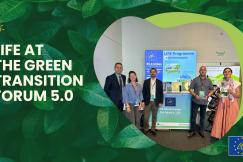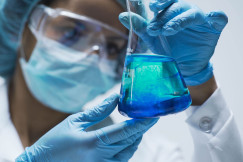News & articles
02 September 2025
Halting microplastic pollution with LIFE BLUE LAKES
News & articles
02 September 2025
Green transition
Login / create an account to be able to react
-
10

Tiny fragments of plastic known as microplastics are accumulating in Europe’s lakes, but the LIFE BLUE LAKES project has brought communities, companies and local policymakers together to tackle this pollution.
Editorial team
European Commission
Topics
Albania
Armenia
Austria
Belgium
Bosnia and Herzegovina
Bulgaria
Croatia
Cyprus
Czechia
Denmark
Estonia
EU-27
Finland
France
Georgia
Germany
Greece
Hungary
Iceland
Ireland
Italy
Kosovo
Latvia
Liechtenstein
Lithuania
Luxembourg
Malta
Moldova
Montenegro
Netherlands
North Macedonia
Norway
Poland
Portugal
Romania
Serbia
Slovakia
Slovenia
Spain
Sweden
Switzerland
Türkiye
Ukraine
Other
EU Institutions
-
Policy type
-
-
Green transition
-
Share
Europe's landscape is dotted with thousands of lakes. The vital freshwater environments they provide for people and wildlife are being celebrated as part of the first ever UN World Lake Day.
But despite their importance, some of Europe's most treasured lakes are polluted with tiny fragments from plastic bags and synthetic fabrics, according to a LIFE project that has been searching for solutions to this problem.
The LIFE BLUE LAKES project spent 4 years trying to understand the scale of the challenge caused by microplastics – fragments of plastic less than 5mm in size – at several lakes in Italy and Germany. Pilot monitoring projects at 3 Italian lakes – Bracciano, Trasimeno and Piediluco – over a 2-year period revealed 98 % of water samples were contaminated with plastic particles. In total the project team collected more than 9 000 plastic fragments in the samples. Most came from old plastic bags that break down into ever smaller pieces.
Researchers on the project also developed methods for monitoring microplastics at 3 drinking water and 2 wastewater treatment plants at Lake Garda near Milan and at Castreccioni near Macerata. They found 30-90 % of microplastics are retained in the treatment process, with the majority coming from polyester and polypropylene clothing.
But the remainder escape into the environment, where they can harm freshwater life in lakes and rivers or pose a risk to human health.
‘‘We are at a point in history where understanding how to deal with this type of pollution can occur in parallel with the challenge of stopping the phenomenon,’’ says Giorgio Zampetti, director general of Legambiente, an environmental organisation in Italy, and coordinator of the LIFE BLUE LAKES project, which concluded in 2023.
Comments (0)
See also
LIFE Programme draws the crowds at the Green Transition Forum 5.0
- Categories
Energy Union Task Force looks at readiness of energy networks
- Categories
Highlights from ECHA’s Member State Committee October meeting
- Categories




